数据结构实验指导书源代码
数据结构上机实验源代码
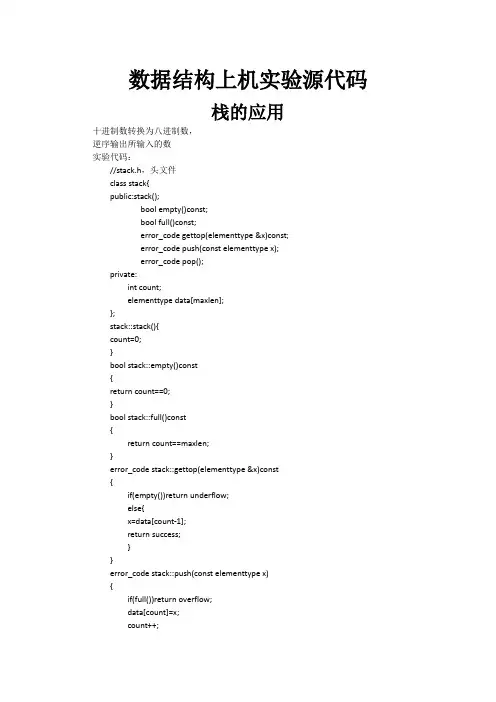
数据结构上机实验源代码栈的应用十进制数转换为八进制数,逆序输出所输入的数实验代码://stack.h,头文件class stack{public:stack();bool empty()const;bool full()const;error_code gettop(elementtype &x)const;error_code push(const elementtype x);error_code pop();private:int count;elementtype data[maxlen];};stack::stack(){count=0;}bool stack::empty()const{return count==0;}bool stack::full()const{return count==maxlen;}error_code stack::gettop(elementtype &x)const{if(empty())return underflow;else{x=data[count-1];return success;}}error_code stack::push(const elementtype x){if(full())return overflow;data[count]=x;count++;return success;}error_code stack::pop(){if(empty())return underflow;count--;return success;}//主程序#include<iostream.h>enum error_code{overflow,underflow,success};typedef int elementtype;const int maxlen=20;#include"stack.h"void read_write() //逆序输出所输入的数{stack s;int i;int n,x;cout<<"please input num int n:";cin>>n;for(i=1;i<=n;i++){cout<<"please input a num:";cin>>x;s.push(x);}while(!s.empty()){s.gettop(x);cout<<x<<" ";s.pop();}cout<<endl;}void Dec_to_Ocx(int n) //十进制转换为八进制{stack s1;int mod,x;while(n!=0){mod=n%8;s1.push(mod);n=n/8;}cout<<"the ocx of the dec is:";while(!s1.empty()){s1.gettop(x);cout<<x;s1.pop();}cout<<endl;}void main(){int n;// read_write();cout<<"please input a dec:";cin>>n;Dec_to_Ocx(n);}队列的应用打印n行杨辉三角实验代码://queue.hclass queue{public:queue(){count=0;front=rear=0;}bool empty(){return count==0;}bool full(){return count==maxlen-1;}error_code get_front(elementtype &x){if(empty())return underflow;x=data[(front+1)%maxlen];return success;}error_code append(const elementtype x){if(full())return overflow;rear=(rear+1)%maxlen;data[rear]=x;count++;return success;}error_code serve(){if(empty())return underflow;front=(front+1)%maxlen;count--;return success;}private:int count;int front;int rear;int data[maxlen];};//主程序#include<iostream.h>enum error_code{overflow,underflow,success};typedef int elementtype;const int maxlen=20;#include"queue.h"void out_number(int n) //打印前n行的杨辉三角{int s1,s2;int i;int j;int k;queue q;for(i=1;i<=(n-1)*2;i++)cout<<" ";cout<<"1 "<<endl;q.append(1);for(i=2;i<=n;i++){s1=0;for(k=1;k<=(n-i)*2;k++)cout<<" ";for(j=1;j<=i-1;j++){q.get_front(s2);q.serve();cout<<s1+s2<<" ";q.append(s1+s2);s1=s2;}cout<<"1 "<<endl;q.append(1);}}void main(){int n;cout<<"please input n:";cin>>n;out_number(n);}单链表实验实验目的:实验目的(1)理解线性表的链式存储结构。
数据结构试验完整代码
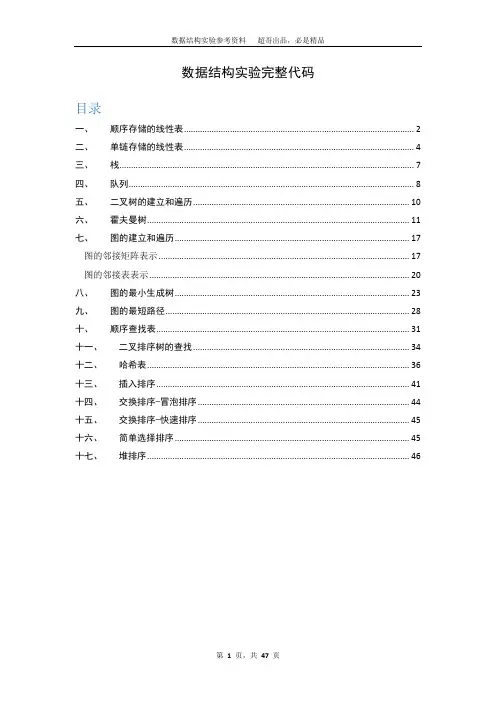
数据结构实验完整代码目录一、顺序存储的线性表 (2)二、单链存储的线性表 (4)三、栈 (7)四、队列 (8)五、二叉树的建立和遍历 (10)六、霍夫曼树 (11)七、图的建立和遍历 (17)图的邻接矩阵表示 (17)图的邻接表表示 (20)八、图的最小生成树 (23)九、图的最短路径 (28)十、顺序查找表 (31)十一、二叉排序树的查找 (34)十二、哈希表 (36)十三、插入排序 (41)十四、交换排序-冒泡排序 (44)十五、交换排序-快速排序 (45)十六、简单选择排序 (45)十七、堆排序 (46)一、顺序存储的线性表typedef struct{char name[10];char no[10];double grade;}Student;typedef struct{Student *elem;int length;int listsize;}SqList;void Display(SqList *L){int i;for (i=0;i<L->length ;i++){cout<<i+1<<":姓名"<<L->elem[i].name<<",学号:"<<L->elem[i].no<<",成绩:"<<L->elem[i].grade <<endl;}cout<<"请选择菜单项:";}SqList *CreateList(){SqList *L;L=(SqList*)malloc(sizeof(SqList));if(!L) cout<<"建立线性表失败!";else cout<<"建立线性表成功!";return(L);}int InitList(SqList *L){int i;char name[10],no[10];double grade;L->elem=(Student *)malloc(ListInitSize * sizeof(Student));if (!(L->elem)) cout<<"初始化表失败!";L->length = 0;L->listsize = ListInitSize;cout<<"请输入要录入信息的学生个数:"<<endl;cin>>i;if (i>(L->listsize)){L->elem =(Student *)realloc(L->elem ,i*sizeof(Student));}for (int j=0;j<i;j++){cout<<"请输入第"<<j+1<<"个学生的信息:"<<endl;cin>>name>>no>>grade;strcpy((L->elem+L->length)->name,name);strcpy((L->elem+L->length)->no,no);(L->elem+L->length)->grade =grade;L->length ++;}cout<<"信息录入完成!";return 0;}int Insert(SqList *l){Student e;int i,j;Student *newbase;cout<<"请输入要插入的位置:";cin>>j;j--;cout<<"请输入学生信息:";cin>>>>e.no>>e.grade;if(l->length==l->listsize){newbase=(Student*)realloc(l->elem,(l->listsize+ListIncreasement)*sizeof(Studen t));if(!newbase){cout<<"出错!";return 0;}l->elem=newbase;l->listsize+=ListIncreasement;}for(i=l->length;i>=j;i--){l->elem[i+1] = l->elem[i];}l->elem[j]=e;l->length++;cout<<"插入成功!";return 0;}int Delect(SqList *L){int i,j;cout<<"输入删除信息的位置:";cin>>j;j--;cout<<"删除的信息为:姓名:"<<L->elem[j].name<<",学号:"<<L->elem[j].no<<"成绩:"<<L->elem[j].grade<<endl;for(i=j+1;i<=L->length;i++){L->elem[i-1]=L->elem[i];}L->length--;cout<<"请按回车继续"<<endl;getchar();getchar();cout<<"删除成功!";return 0;}二、单链存储的线性表typedef struct Student{char name[10];char no[10];double grade;}Student;typedef struct LNode{Student data;LNode *next;}LNode,*LinkList;void CreateList(LinkList &l){l=(LinkList)malloc(sizeof(LNode));if (!l) cout<<"建立失败。
数据结构与算法实验源代码

数据结构与算法实验源代码数据结构与算法实验源代码1.实验目的本实验旨在通过实践,加深对数据结构与算法的理解与应用能力,掌握数据结构和算法的基本概念与原理,并能够运用所学知识解决实际问题。
2.实验材料●一台已安装好编译器的计算机●数据结构与算法实验源代码文件3.实验环境配置在实验开始之前,必须确保计算机上已安装好以下环境:●编译器(可以是C++、Java等)●数据结构与算法实验源代码文件4.实验内容及步骤4.1 实验一:线性表4.1.1 实验目的通过实现线性表的相关操作,加深对线性表及其操作的理解,并能够灵活应用。
4.1.2 实验步骤1.实现线性表的初始化函数2.实现线性表的插入操作3.实现线性表的删除操作4.实现线性表的查找操作5.实现线性表的排序操作6.实现线性表的输出操作7.编写测试代码,对线性表进行测试4.1.3 实验结果与分析进行若干测试用例,验证线性表的正确性,并分析算法的时间复杂度与空间复杂度。
4.2 实验二:栈与队列4.2.1 实验目的通过实现栈与队列的相关操作,加深对栈与队列的理解,并掌握栈与队列的应用场景。
4.2.2 实验步骤1.实现栈的初始化函数2.实现栈的入栈操作3.实现栈的出栈操作4.实现栈的查看栈顶元素操作5.实现队列的初始化函数6.实现队列的入队操作7.实现队列的出队操作8.实现队列的查看队首元素操作4.2.3 实验结果与分析进行若干测试用例,验证栈与队列的正确性,并分析算法的时间复杂度与空间复杂度。
(继续添加实验内容及步骤,具体根据实验项目和教学要求进行详细分析)5.实验附件本文档所涉及的实验源代码文件作为附件随文档提供。
6.法律名词及注释6.1 版权:著作权法所规定的权利,保护作品的完整性和原创性。
6.2 开源:指软件可以被任何人免费使用、分发和修改的一种软件授权模式。
(继续添加法律名词及注释)。
数据结构实验二的源代码
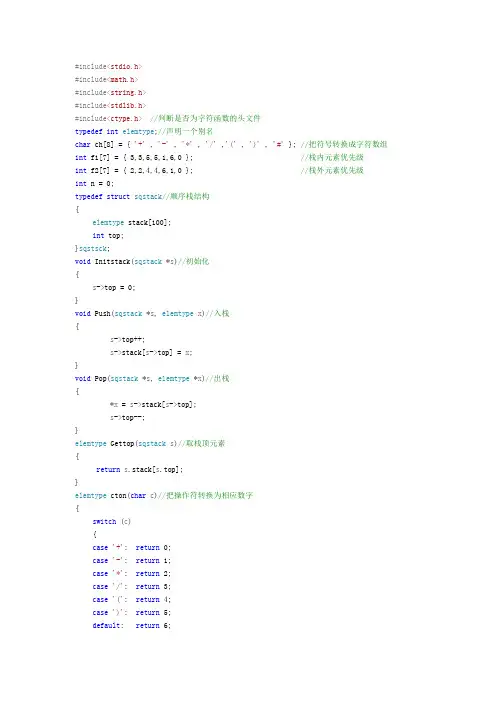
#include<stdio.h>#include<math.h>#include<string.h>#include<stdlib.h>#include<ctype.h>//判断是否为字符函数的头文件typedef int elemtype;//声明一个别名char ch[8] = { '+' , '-' , '*' , '/' ,'(' , ')' , '#' }; //把符号转换成字符数组int f1[7] = { 3,3,5,5,1,6,0 }; //栈内元素优先级int f2[7] = { 2,2,4,4,6,1,0 }; //栈外元素优先级int n = 0;typedef struct sqstack//顺序栈结构{elemtype stack[100];int top;}sqstsck;void Initstack(sqstack *s)//初始化{s->top = 0;}void Push(sqstack *s, elemtype x)//入栈{s->top++;s->stack[s->top] = x;}void Pop(sqstack *s, elemtype *x)//出栈{*x = s->stack[s->top];s->top--;}elemtype Gettop(sqstack s)//取栈顶元素{return s.stack[s.top];}elemtype cton(char c)//把操作符转换为相应数字{switch (c){case'+': return 0;case'-': return 1;case'*': return 2;case'/': return 3;case'(': return 4;case')': return 5;default: return 6;}}char Compare(char c1, char c2)//比较字符优先级{int i1 = cton(c1);int i2 = cton(c2); //把字符变成数字if (f1[i1] > f2[i2]) return'>'; //通过原来的设定找到优先级else if (f1[i1] < f2[i2]) return'<';else return'=';}int Operate(elemtype a, elemtype t, elemtype b)//四则运算{int sum;switch (t){case 0: sum = a + b; break;case 1: sum = a - b; break;case 2: sum = a * b; break;default: sum = a / b;}return sum;}int Expression()//主要表达式函数{char c;int i = 0, sum = 0;int k = 1, j = 1; //设置开关变量elemtype x, t, a, b;sqstack OPTR, OPND;Initstack(&OPTR);Push(&OPTR, cton('#')); //‘#’压入栈Initstack(&OPND);c = getchar();while (c != '#' || ch[Gettop(OPTR)] != '#'){if (isdigit(c)) //判断c是否为数字{sum = 0;while (isdigit(c)){if (!j) //j用来进行字符串转换判断,j为0转换{sum = sum * 10 - (c - '0');}else sum = sum * 10 + (c - '0'); //字符c转化成对应数字c = getchar();}Push(&OPND, sum);j = 1;}else if (k){switch (Compare(ch[Gettop(OPTR)], c)){case'<': Push(&OPTR, cton(c)); //把字符整型化,然后压入操作符栈c = getchar();break;case'=': Pop(&OPTR, &x); //操作符栈顶元素出栈c = getchar();break;case'>': Pop(&OPTR, &t); //操作符栈顶元素出栈Pop(&OPND, &b); //操作数栈顶元素出栈Pop(&OPND, &a); //操作数栈顶元素出栈Push(&OPND, Operate(a, t, b));break;}}}return (Gettop(OPND));}void main(){int result;printf("请输入'#'号结束:\n");result =Expression();printf("结果为:%d\n", result);system("color 6");system("pause");}。
《数据结构》实验指导书(源代码)
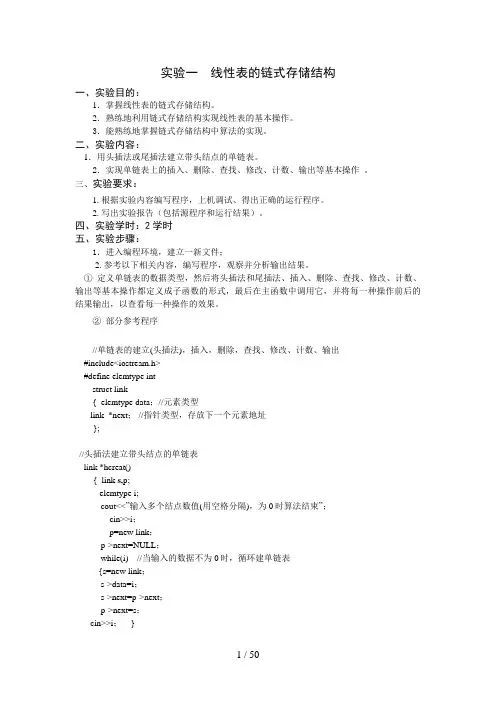
实验一线性表的链式存储结构一、实验目的:1.掌握线性表的链式存储结构。
2.熟练地利用链式存储结构实现线性表的基本操作。
3.能熟练地掌握链式存储结构中算法的实现。
二、实验内容:1.用头插法或尾插法建立带头结点的单链表。
2.实现单链表上的插入、删除、查找、修改、计数、输出等基本操作。
三、实验要求:1. 根据实验内容编写程序,上机调试、得出正确的运行程序。
2. 写出实验报告(包括源程序和运行结果)。
四、实验学时:2学时五、实验步骤:1.进入编程环境,建立一新文件;2. 参考以下相关内容,编写程序,观察并分析输出结果。
①定义单链表的数据类型,然后将头插法和尾插法、插入、删除、查找、修改、计数、输出等基本操作都定义成子函数的形式,最后在主函数中调用它,并将每一种操作前后的结果输出,以查看每一种操作的效果。
②部分参考程序//单链表的建立(头插法),插入,删除,查找、修改、计数、输出#include<iostream.h>#define elemtype intstruct link{ elemtype data;//元素类型link *next; //指针类型,存放下一个元素地址};//头插法建立带头结点的单链表link *hcreat(){ link s,p;elemtype i;cout<<”输入多个结点数值(用空格分隔),为0时算法结束”;cin>>i;p=new link;p->next=NULL;while(i) //当输入的数据不为0时,循环建单链表{s=new link;s->data=i;s->next=p->next;p->next=s;cin>>i; }return p;}//输出单链表void print(1ink *head){1ink *p;p=head->next;while(p->next!=NULL){cout<<p->data<<”->”; //输出表中非最后一个元素p=p->next;}cout<<p->data; //输出表中最后一个元素cout<<endl;}∥在单链表head中查找值为x的结点Link *Locate(1ink *head,elemtype x){Link *p;p=head->next;while((p!=NULL)&&(p->data!=x))p=p->next;return p; }//在head为头指针的单链表中,删除值为x的结点void deletel(1ink *head,elemtype x){1ink *p, *q;q=head;p=head->next;while((p!=NULL)&&(p->data!=x)){q=p;p=p->next;}If(p==NULL) cout<<“要删除的结点不存在”;elseq->next=p ->next;delete(p);}}//在头指针head所指的单链表中,在值为x的结点之后插入值为y的结点void insert(1ink *head,elemtype x,elemtype y){ link *p, *s;s=new link;s->data=y;if(head->next==NULL) //链表为空{head->next=s;s->next=NULL:}p=Locate(head,x);//调用查找算法‘if(p==NULL)cout<<”插入位置非法”:else(s->next=p->next;p->next=s;}}//将单链表p中所有值为x的元素修改成y void change(1ink *p,elemtype x,elemtype y) {link *q;q=p->next;while(q!=NULL){ if(q->data==x) q->data=y;q=q->next;}}void count(1ink *h) //统计单链表中结点个数{1ink *p;int n=0;p=h->next;while(p!=NULL){n++;p=p->next;}return n;}void main(){ int n;elemtype x,y;link *p, *q;p=hcreat(); //头插法建立链表print(p); //输出刚建立的单链表cout<<”请输入要删除的元素”;cin>>y;deletel(p,y);print(p); //输出删除后的结果cout<<”请输入插入位置的元素值(将待插元素插入到它的后面)”; cin>>x;cout<<”请输入待插元素值”;cin>>y;insert(p,x,y);print(p); //输出插入后的结果cout<<”请输入要修改前、后的元素值”;cin>>x>>y;change(p,x,y);print(p);cout<<”请输入要查找的元素值”;cin>>x;q=Locate(p,x);if(q==NULL)cout<<x<<”不在表中,找不到!”<<endl;else cout<<x<<”在表中,已找到!”<<endl;n=count(p);cout<<”链表中结点个数为:”<<n<<endl:}//单链表的建立(尾插法)、插入、删除、查找、修改、计数、输出#include<iostream.h>#define elemtype intstruct link{ elemtype data;//元素类型link *next;//指针类型,存放下-个元素地址};//尾插法建立带头结点的单链表link *rcreat(){link *s, *p, *r;elemtype i;cout<<”输入多个结点数值(用空格分隔),为0时算法结束”; cin>>i;p=r=new link;p->next=NULL;while(i){s=new link;s->data=i;r->next=s;r=s;cin>>i; }r->next=NULL;return p;}//输出单链表void print(1ink *head){link *p;p=head->next;while(p->next!=NULL){cout<<p->data<<"->”; //输出表中非最后一个元素p=p->next;)cout<<p->data; //输出表中最后一个元素cout<<endl;}link *Locate(1ink *head,int x) ∥在单链表中查找第x个结点 {link *p;p=head;int j=0;while((p!=NULL)&&(j<x)){p=p->next; j++;}return p;}void delete I(1ink *head,elemtype x)//在head为头指针的单链表中,删除值为x的结点{link *p, *q;q=head;p=head->next;while((p!=NULL)&&(p->data!=x)){q=p;p=p->next;)if(p==NULL)cout<<”要删除的结点不存在“;else{q->next=p->next;delete(p);} }void insert(1ink *head,int x,elemtype y)//在头指针head所指单链表中,在第x个结点之后插入值为y的结点{link *p, *s;s=new link;s->data=y;if(head->next==NULL)//链表为空{head->next=s;s->next=NULL:}p=Locate(head,x); //调用查找算法if(p==NULL)cout<<”插入位置非法”;else{s->next=p->next;p->next=s;}}void change(1ink *p,elemtype x,elemtype y){∥将单链表P中所有值为x的元素改成值为ylink *q;q=p->next;while(q!=NULL){if(q->data==x)q->data=y;q=q->next;}}void count(1ink *h) //统计单链表中结点个数(1ink *p;int n=0;p=h->next;while(p!=NULL){n++;p=p->next;}retum n;}void main(){ int n;link p,q;p=rcreat();//尾插法建立链表print(p); //输出刚建立的单链表cout<<”请输入要删除的元素”;cin>>y;deletel(p,y);print(p); //输出删除后的结果cout<<”请输入插入位置”;cin>>x;cout<<”请输入待插元素值”;cin>>y;insert(p,x,y);print(p); //输出插入后的结果cout<<”请输入修改前、后的元素值”;cin>>x>>y;change(p,x,y);print(p);cout<<“请输入要查找的元素值”;cin>>x;q=Locate(p ,x);if(q==NULL)cout<<x<<”不在表中,找不到!”<<endl;else cout<<x<<”在表中,已找到!”<<endl;n=count(p);cout<<”链表中结点个数为:”<<n<endl;}六、选作实验试设计一元多项式相加(链式存储)的加法运算。
数据结构课本算法源代码
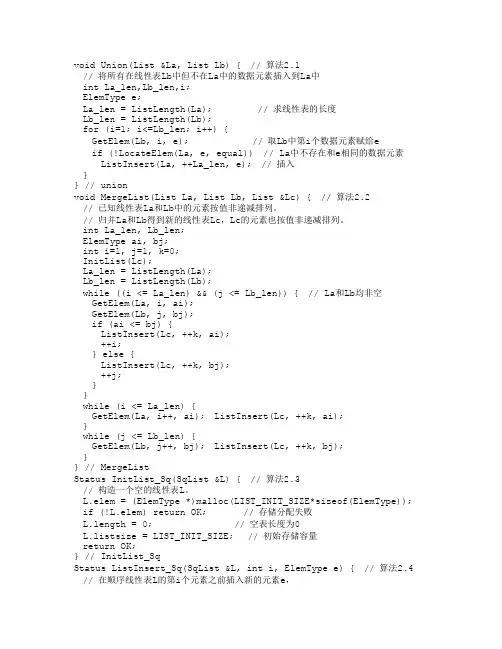
void Union(List &La, List Lb) { // 算法2.1// 将所有在线性表Lb中但不在La中的数据元素插入到La中int La_len,Lb_len,i;ElemType e;La_len = ListLength(La); // 求线性表的长度Lb_len = ListLength(Lb);for (i=1; i<=Lb_len; i++) {GetElem(Lb, i, e); // 取Lb中第i个数据元素赋给eif (!LocateElem(La, e, equal)) // La中不存在和e相同的数据元素ListInsert(La, ++La_len, e); // 插入}} // unionvoid MergeList(List La, List Lb, List &Lc) { // 算法2.2// 已知线性表La和Lb中的元素按值非递减排列。
// 归并La和Lb得到新的线性表Lc,Lc的元素也按值非递减排列。
int La_len, Lb_len;ElemType ai, bj;int i=1, j=1, k=0;InitList(Lc);La_len = ListLength(La);Lb_len = ListLength(Lb);while ((i <= La_len) && (j <= Lb_len)) { // La和Lb均非空GetElem(La, i, ai);GetElem(Lb, j, bj);if (ai <= bj) {ListInsert(Lc, ++k, ai);++i;} else {ListInsert(Lc, ++k, bj);++j;}}while (i <= La_len) {GetElem(La, i++, ai); ListInsert(Lc, ++k, ai);}while (j <= Lb_len) {GetElem(Lb, j++, bj); ListInsert(Lc, ++k, bj);}} // MergeListStatus InitList_Sq(SqList &L) { // 算法2.3// 构造一个空的线性表L。
数据结构实验指导书源程序附件
附录:实验源程序实验一、线性表操作程序1:顺序存储的线性表和运算#include<stdio.h>#define MAXSIZE 100int list[MAXSIZE];int n;/*insert in a seqlist*/int sq_insert(int list[], int *p_n, int i, int x){int j;if (i<0 || i>*p_n) return(1);if (*p_n==MAXSIZE) return(2);for (j=*p_n+1; j>i; j--)list[j]=list[j-1];list[i]=x;(*p_n)++;return(0);}/*delete in a seq list*/int sq_delete(int list[], int *p_n, int i){int j;if (i<0 || i>=*p_n) return(1);for (j = i+1; j<=*p_n; j++)list[j-1] = list[j];(*p_n)--;return(0);}void main(){int i,x,temp;printf("please input the number for n\n");printf("n=");scanf("%d",&n);for (i=0; i<=n; i++){printf("list[%d]=",i);scanf("%d",&list[i]);}printf("The list before insertion is\n");for (i=0; i<=n; i++) printf("%d ",list[i]);printf("\n");printf("please input the position where you want to insert a value\nposition=");scanf("%d",&i);printf("please input the value you want to insert.\nx=");scanf("%d",&x);temp=sq_insert(list,&n,i,x);switch(temp){case 0:printf("The insertion is successful!\n");printf("The list is after insertion is\n");for(i=0; i<=n; i++) printf("%d ",list[i]);printf("\n");printf("%d\n",n);break;case 1:case 2:printf("The insertion is not successful!\n");break;}/*deleting*/printf("The list before deleting is\n");for (i=0; i<=n; i++) printf("%d ",list[i]);printf("\n");printf("please input the position where you want to delete a value\nposition=");scanf("%d",&i);temp=sq_delete(list,&n,i);switch(temp){case 0:printf("The deleting is successful!\n");printf("The list is after deleting is\n");for(i=0; i<=n; i++) printf("%d ",list[i]);printf("\n");printf("%d",n);break;case 1:printf("The deleting is not successful!");break;}}程序2链式存储的线性表和运算#include<stdio.h>#include<malloc.h>struct node{char data;struct node *next;};typedef struct node NODE;/*This function creates a link_list with N nodes.*/NODE *create_link_list(int n){int i;NODE *head, *p, *q;if (n==0) return NULL;head = (NODE *) malloc(sizeof(NODE));p = head;printf("Please input %d chars for the link list\n",n);for (i=0; i<n; i++){scanf("%c ", &(p->data));q=(NODE *)malloc(sizeof(NODE));printf("test3\n");p->next=q;p=q;}scanf("%c ",&(p->data));getchar();p->next=NULL;return (head);}/*This function inserts a node whose value is b*//*before the node whose value is a, if the node is not exist,*/ /*then insert it at the end of the list*/void insert(NODE **p_head, char a, char b){NODE *p, *q;q = (NODE *)malloc(sizeof(NODE));q->data = b;q->next =NULL;if (* p_head == NULL) * p_head = q;else{p=(NODE*)malloc(sizeof(NODE));p = * p_head;while (p->data != a && p->next != NULL)p = p->next;q->next = p->next;p->next = q;}}/*The function deletes the node whose value is a,*//*if success, return 0, or return 1*/int deletenode(NODE **p_head, char a){NODE *p, *q;q=*p_head;if (q==NULL) return(1);if (q->data == a){* p_head = q->next;free(q);return (0);}else{while (q->data != a && q->next != NULL){p = q;q = q->next;}if (q->data == a){p->next = q->next;free(q);return(0);}else return(1);}}void main(){ NODE *my_head,*p;/* create a link list with m nodes */int m;char ch_a,ch_b;printf("please input the number of nodes for the link_list\nm=");scanf("%d",&m);getchar();printf("test1\n");my_head = (NODE *) malloc(sizeof(NODE));my_head=create_link_list(m);/*Output the link list*/printf("The link list is like:\n");p=my_head;while (p != NULL){printf("%c ",p->data);p=p->next;}printf("\n");/*insert a node whose value is b before a*/printf("Please input the position for a\n ch_a=");getchar();scanf("%c",&ch_a);getchar();printf("Please input the value that you want to insert\n ch_b=");scanf("%c",&ch_b);getchar();insert(&my_head,ch_a,ch_b);printf("The link list after insertion is like:\n");p=my_head;while (p != NULL){printf("%c ",p->data);p=p->next;}printf("\n");/*delete a node whose value is a*/printf("Please input the position for a a=");scanf("%c",&ch_a);getchar();deletenode(&my_head,ch_a);printf("The link list after deleting is like:\n");p=my_head;while (p != NULL){printf("%c ",p->data);p=p->next;}printf("\n");}实验二、栈和队列的应用程序1:顺序栈的实现和运算#include<stdio.h>#define MAXN 26char stack[MAXN];int top=0;int push(char x){if (top >= MAXN)return(1);stack[top++]=x;return(0);}int pop(char *p_y){if (top == 0)return(1);*p_y = stack[--top];return(0);}void main(){ int i;char ch_x,ch_y;printf("input the char you want to push\n");scanf("%c",&ch_x);while(ch_x!='0')if (push(ch_x)==1) printf("failure!\n");else{printf("success!\n");printf("input a char for ch_x to push\nch_x=");getchar();scanf("%c",&ch_x);}i=0;while(stack[i]!='\0'){printf("%c ", stack[i]);i++;}if (pop(&ch_y)==1) printf("failure!\n");else{printf("success!\n");printf("The pop char is %c\n",ch_y);} for (i=top-1; i>=0; i--)printf("%c ", stack[i]);}程序2:链栈的实现和运算#include <stdio.h>#include <malloc.h>struct node{char data;struct node *link;};typedef struct node NODE;NODE * top = NULL;void push_l(char x){NODE *p;p = (NODE * )malloc(sizeof(NODE));p->data = x;p->link = top;top = p;}int pop_l(char *p_y){NODE *p;if (top == NULL)return(1);* p_y = top->data;p = top;top = top->link;free(p);return(0);}void main(){ NODE *p;char ch_x,ch_y;printf("input the char you want to push\n");scanf("%c",&ch_x);while(ch_x!='0'){push_l(ch_x);getchar();scanf("%c",&ch_x);}p=(NODE*)malloc(sizeof(NODE));p=top;while(p!=NULL){printf("%c ",p->data);p=p->link;}printf("\n");if (pop_l(&ch_y)==1) printf("failure!\n");else{printf("success!\n");printf("The pop char is %c\n",ch_y);}p=(NODE*)malloc(sizeof(NODE));p=top;while(p!=NULL){printf("%c ",p->data);p=p->link;}printf("\n");}程序3:顺序队列的实现和运算#include<stdio.h>#define MAXN 26char q[MAXN];int head = -1, tail = -1;int en_queue(char x ){if (tail == MAXN-1)return(1);q[++tail] = x;return(0);}int de_queue(char *p_y ){if (head == tail)return(1);*p_y = q[++head];return(0);}void main(){ int i;char ch_x,ch_y;printf("input the char you want to enqueue\n");scanf("%c",&ch_x);while(ch_x!='0')if (en_queue(ch_x)==1) printf("failure!\n");else{printf("success!\n");printf("input a char for ch_x to enqueue\nch_x=");getchar();scanf("%c",&ch_x);}i=1;while(q[i]!='\0'){printf("%c ", q[i]);i++;}if (de_queue(&ch_y)==1) printf("failure!\n");else{printf("success!\n");printf("The dequeue char is %c\n",ch_y);}for (i=head+1; i<=tail; i++)printf("%c ", q[i]);}程序4:链式队列的实现和运算#include<stdio.h>#include<malloc.h>"struct node{char data;struct node * link;};typedef struct node NODE;NODE *head, *tail;void en_queue_l(char x){NODE *p;p = (NODE *)malloc(sizeof(NODE));p->data = x;p->link = NULL;if (head == NULL)head = p;elsetail->link = p;tail = p;}int de_queue_l(char *p_y){NODE *p;if (head == NULL)return(1);*p_y = head->data;p = head;head = head->link;free(p);return(0);}void main(){ NODE *p;char ch_x,ch_y;printf("input the char you want to enqueue\n");scanf("%c",&ch_x);while(ch_x!='0'){en_queue_l(ch_x);getchar();scanf("%c",&ch_x);}p=(NODE*)malloc(sizeof(NODE));p=head;while(p!=NULL){printf("%c ",p->data);p=p->link;}printf("\n");if (de_queue_l(&ch_y)==1) printf("failure!\n");else{printf("success!\n");printf("The dequeue char is %c\n",ch_y);} p=(NODE*)malloc(sizeof(NODE));p=head;while(p!=NULL){printf("%c ",p->data);p=p->link;}printf("\n");}程序5:循环队列的实现和运算#include<stdio.h>#include<string.h>#define MAXN 26char q[MAXN];int head = 0, tail = 0;int en_c_q(char x){tail = (tail + 1) % MAXN;if (tail == head){if (tail == 0) tail = MAXN-1;else tail--;return(1);}q[tail] = x;return(0);}int de_c_q(char *p_y){if (head == tail)return(1);head = (head+1) % MAXN;*p_y = q[head];return(0);}void main(){ int i;char ch_x,ch_y;printf("input the char you want to enqueue\n");scanf("%c",&ch_x);while(ch_x!='0')if (en_c_q(ch_x)==1) printf("failure!\n");else{printf("success!\n");printf("input a char for ch_x to enqueue\nch_x=");getchar();scanf("%c",&ch_x);}i=1;while(q[i]!='\0'){printf("%c ", q[i]);i++;}if (de_c_q(&ch_y)==1) printf("failure!\n");else{printf("success!\n");printf("The dequeue char is %c\n",ch_y);}for (i=head+1; i<=tail; i++)printf("%c ", q[i]);}实验三、多维数组和串程序1:稀疏矩阵的存储及转置运算#include <stdio.h>typedef struct {int row ;int col ;int val ;}THA ;#define MAX 20main( ){ int i, j, count=1 ;int col, row, val ;THA s[MAX];THA t[MAX];printf("input the number of row ,col and elements:"); scanf("%d,%d,%d",&s[0].row,&s[0].col,&s[0].val);if(s[0].val==0) return ;val =s[0].val;for(i=1;i<=val;i++);scanf("%d,%d,%d",&s[i].row,&s[i].col,&s[i].val);row = s[0].row ;col= s[0].col ;count=1 ;for( i=1; i<= col ; i++)for ( j=1; j<=val ; j++)if (s[j].col==i){t[count].row = s[j].col;t[count].col = s[j].row;t[count++].val = s[j].val;}t[0].row = col ;t[0].col = row ;t[0].val = val ;for(i=0;i<=val;i++)printf("%d,%d,%d\n",t[i].row,t[i].col,t[i].val); }程序2:串的实现和运算#include <stdio.h>#define MAXN 128typedef enum {fail,success} status;typedef enum {false,true} boolean;main(){ int strlen();void strass();boolean strcmp();status strcat( );status strins();void patmatch();int t,n,i;boolean b;status st;char s[MAXN],s1[MAXN],s2[MAXN];printf("\n1. The length of string\n");printf(" 2. The assignment of string\n");printf(" 3. A string compare with another string:\n");printf(" 4. A string connect with another string:\n");printf(" 5. A string to be inserted into another string\n"); printf(" 6. The pattern match of string :");printf(" Please input a opertation:");scanf("%d",&t);switch(t){ case 1:printf("please input a string:\n");getchar();gets(s);n=strlen(s);printf("the length is: %d",n);break;case 2:printf("please input the first string:\n");getchar();gets(s1);printf("please input the second string:\n");getchar();gets(s2);strass(s1,s2);break;case 3:printf("please input the first string:\n");getchar();gets(s1);printf("please input the second string: \n");gets(s2);b=strcmp(s1,s2);if (b==true)printf("equal\n");elseprintf("not equal\n");break;case 4:printf("please input the first string:\n");getchar();gets(s1);printf("please input the second string:\n");gets(s2);st=strcat(s1,s2);if(st==success)printf("answer is %s\n",s1);elseprintf("error!\n");break;case 5:printf("please input the first string:\n");getchar();gets(s1);printf("please input the second string:\n");gets(s2);printf("please input i:");scanf("%d",&i);st=strins(s1,i,s2);if(st==success)printf("answer is %s\n",s1);else printf("error!\n");break;case 6:patmatch();break;default: printf("There isn't this operation!"); }}int strlen(s)char s[];{ int i;for(i=0;s[i]!='\0';i++);return (i);}void strass(s1,s2)char s1[],s2[];{ int i=0;while(s1[i]!='\0'){ s2[i]=s1[i];i++;}s2[i]='\0';printf("s2 is %s",s2);}boolean strcmp(s1,s2)char s1[],s2[];{ int i=0;while (s1[i]==s2[i] && s1[i]!='\0' && s2[i]!='\0') i++;if (s1[i]=='\0' && s2[i]=='\0')return (true);elsereturn (false);}status strcat (s1,s2)char s1[],s2[];{ int i,j,k;i=strlen(s1);j=strlen(s2);if((i+j)>=MAXN)return(fail);for(k=0;k<=j;k++)s1[i+k]=s2[k];return (success);}status strins (s1,i,s2)char s1[],s2[];int i;{ int m,n,k;m=strlen(s1);n=strlen(s2);if (i<0||i>m||(m+n)>MAXN )return (fail) ;for(k=m;k>=i;k--)s1[k+n]=s1[k];for(k=0;k<n;k++)s1[i+k]=s2[k];return (success);}int smatch(ch,n,pat,m)char ch[],pat[];int n,m;{ int s,p,k;for(s=0;s<=n-m;s++){for(p=0,k=s;p<m&&ch[k]==pat[p];k++,p++);if(p==m)return(s+1);}return(-1);}void patmatch(){ char ch[MAXN],pat[MAXN];int n,m, result;printf("\ninput the primary string:\n");scanf("%s",ch);printf("input the pattern string:\n");scanf("%s",pat);n=strlen(ch);m=strlen(pat);result=smatch(ch,n,pat,m);if(result==-1)printf("\nNo matched found!");else if(result>=0) printf("\nMatched sub string found in position %d",result); }实验四、树和二叉树的操作程序1:二叉树的实现和运算#include <stdio.h>#include <stdlib.h>#include <malloc.h>typedef struct btnode{char data; /*suppose the data field's type is char*/struct btnode *lchild; /*left pointer field */struct btnode *rchild; /*right pointer field */}NODE;void main(){ NODE *root,*q,n;NODE *create(NODE *p);void preorder(NODE *root);void inorder(NODE *root);void postorder(NODE *root);int t;q=&n;root=create(q);printf("At the first,we create a tree\n");printf("Please input nodes of tree\n");if (root==NULL) printf("It's an empty tree!\n");else{printf("\n1.The preordetraverse \n");printf(" 2.The inordertraverse \n");printf(" 3.The postordertraverse \n");printf(" Please choose a kind of order\n");scanf("%d",&t);switch (t){case 1: preorder(root); break;case 2: inorder(root); break;case 3:postorder(root); break;default: printf(" The error!");}}}NODE * create(NODE *p) /*create the structure of binary tree */ { char ch;NODE *t;scanf("%c",&ch);if(ch==' ') p=NULL;else{p->data=ch;t=(NODE *)malloc(sizeof(NODE));p->lchild=create(t);t=(NODE*)malloc(sizeof(NODE));p->rchild=create(t);}return p;}void preorder(NODE *root) /*travel the tree using preorder */ { if (root!=NULL){ printf( " %c", root->data);preorder(root->lchild);preorder(root->rchild);}return;}void inorder (NODE *root) /*travel the tree using inorder */ { if (root!=NULL){ inorder(root->lchild);printf(" %c ", root->data);inorder(root->rchild);}return;}void postorder(NODE *root) /*travel the tree using postorder */{ if (root!=NULL){ postorder (root->lchild);postorder (root->rchild);printf(" %c ", root->data);}return;}程序2:线索二叉树的实现和运算#include <stdio.h>#include <stdlib.h>#include <malloc.h>struct btnode{ char data; /*data field*/int lbit; /*left flag field*/int rbit; /*right flag field*/struct btnode *lchild; /*left pointer field */struct btnode *rchild; /*right pointer fieldò**/ };typedef struct btnode NODE;NODE *pre;void main(){ NODE * create(NODE *p );void inthread(NODE *root );NODE *q,*root ;q=(NODE *)malloc(sizeof(NODE));printf("\nAt first,we create a tree!\n" );printf("Please input the data of the tree!\n" );root=create(q);inthread(root);}NODE * create(NODE *p) /*create a structure of binary tree */ { char ch;NODE *t; /*suppose the type of the data is int */scanf("%c",&ch);if(ch==' ')p=NULL;else{ p->data=ch;p->lbit=0;t=(NODE *)malloc(sizeof(NODE));p->lchild=create(t);t=(NODE*)malloc(sizeof(NODE));p->rchild=create(t);}return p;}void inthread(NODE *root ){void inthreading(NODE **p);void invodth(NODE **h);NODE *t;t=((NODE *)malloc(sizeof(NODE)));t->lbit=0; t->rbit=1;t->rchild=t;if (root==NULL)t->lchild=t;else{ pre=t;inthreading(&root); /*produce the thread tree using inorder */t->lchild=root; /* the last node form the thread */pre->rchild=t;pre->rbit=1;t->rchild=pre;}invodth(&t);}void inthreading(NODE **p){ if ((*p)!=NULL){inthreading(&((*p)->lchild)); /*left subtree form the thread */if(((*p)->lchild)==NULL){ (*p)->lbit=1;(*p)->lchild=pre;}if (pre->rchild==NULL){ pre->rbit=1;pre->rchild=*p;}pre=*p;inthreading(&((*p)->rchild));/*right subtree form the thread*/}}void invodth(NODE **h) /*travel the binary tree using the inorder thread */ { NODE *p;p=(*h)->lchild;while(p!=(*h)){ while (p->lbit==0)p=p->lchild;if (p->lbit==1)printf(" %c",p->data);while ( p->rbit==1 && p->rchild!=(*h)){ p=p->rchild;printf(" %c",p->data);}p=p->rchild;}}程序3:哈夫曼树的实现和运算#include<stdio.h>#include <stdlib.h>#include <malloc.h>#define m 100struct ptree /* define the type of binary tree*/ { int w;struct ptree * lchild;struct ptree * rchild;};struct pforest /*define the type of chain belt*/{ struct pforest *link;struct ptree *root;};int WTL=0;void main(){ struct ptree *hafm(int w[m],int n );void travel(struct ptree *head,int n );struct ptree *head;int n,i,w[m];printf("please input the sum of node\n");scanf("%d",&n);printf("please input weight of every node\n");for(i=1;i<=n;i++)scanf("%d",&w[i]);head=hafm(w,n);travel(head,0);printf("The length of the best path is WTL=%d",WTL); }void travel(struct ptree *head,int n){ struct ptree *p;p=head;if (p!=NULL){ if((p->lchild)==NULL&&(p->rchild)==NULL){ printf(" %d",p->w);printf(" the hops of the node is: %d\n",n);WTL=WTL+n*(p->w);}travel(p->lchild,n+1);travel(p->rchild,n+1);}}struct ptree *hafm(int w[m],int n){ struct pforest *inforest(struct pforest *f, struct ptree *t ); struct pforest *p1,*p2,*f;struct ptree *ti,*t,*t1,*t2;int i;f=(struct pforest*)malloc(sizeof(struct pforest));f->link=NULL;for (i=1;i<=n;i++) /*produce n trees that have only rootnode*/ {ti=(struct ptree *)malloc(sizeof(struct ptree));ti->w=w[i];ti->lchild=NULL;ti->rchild=NULL;f=inforest (f,ti);}while(((f->link)->link)!=NULL) /* at least have two binary trees*/ { p1=f->link;p2=p1->link;f->link=p2->link; /*take out frontal two trees*/t1=p1->root;t2=p2->root;free(p1);free(p2);t=(struct ptree *)malloc (sizeof(struct ptree));t->w=t1->w+t2->w; /*weight be added */t->lchild=t1;t->rchild=t2; /*produce the new binary tree */f=inforest(f,t);}p1=f->link;t=p1->root;return(t);}struct pforest * inforest(struct pforest *f, struct ptree *t) { struct pforest *p, *q, *r;struct ptree *ti;r=(struct pforest *) malloc(sizeof(struct pforest));r->root=t;q=f;p=f->link;while (p!=NULL) /*look for the position to be inserted*/ { ti=p->root;if( t->w>ti->w ){ q=p;p=p->link;}elsep=NULL; /*force exit the cycle*/}r->link=q->link;q->link=r;return (f);}实验五、图的操作程序1:图的实现和运算#include <stdio.h>#include <stdlib.h>#include <alloc.h>struct node{ int vertex;struct node *next;};struct headnode{ int vert;struct node *link;};main(){ int t,n,i,visit[100];int d[100];struct headnode *adjlist( );void dfs( );void wfs( );struct headnode *head ;printf("input the sum of nodes:\n");scanf("%d",&n);for(i=0;i<n;i++)scanf("%d",&d[i]);head=adjlist(d,n);printf("1 depth travel\n");printf("2 width travel\n");printf("please input the way of travelling\n");scanf("%d",&t);switch (t){ case 1:for(i=0;i<n;i++)visit[i]=0;dfs(head,1,visit);break;case 2:wfs(head,n);break;default:printf("The error!");}}struct headnode *adjlist(d,n)int n;int d[ ];{ struct headnode head[100] ;struct node *q,*p ;int i,v1;for(i=0; i<n;i++){ head[i].vert=d[i];head[i].link=NULL;printf("input linked list of\n");scanf("%d ",&v1);while(v1>=0){ p=(struct node *) malloc(sizeof(struct node));p->vertex=v1;p->next=head[i].link ;head[i].link=p;scanf("%d", &v1);}}return(head);}void dfs(head,k,visit)struct headnode head[1000];int k,visit [ ];{int i;struct node *p;printf(" v%d",k);visit[k]=1;p=head[k-1].link;while ( p!=NULL){if (visit[p->vertex]==0)dfs(head,p->vertex,visit);p=p->next;};return;}void wfs(head,n)struct headnode *head;int n;{int visit[1000],q[1000],f,r,k,u,m; struct node *p;for(k=0;k<n;k++)visit[k]=0;f=0;r=0;m=0;if (visit[m]==0)q[r]=(head+m)->vert;r=r+1;visit[m]=1;while (f!=r){ u=q[f];f=f+1;printf(" v%d",u);p=(head+u-1)->link;while (p!=NULL){ if (visit[p->vertex-1]==0){ q[r]=p->vertex;r=r+1;visit[p->vertex-1]=1;}p=p->next;}}}程序2:最小生成树#define M 30#define MAX 99#include <stdio.h>#include <stdlib.h>main(){void prim();int i,j,n,g[100][100];printf("input the sum of nodes:\n");scanf("%d",&n);printf("input the content of adjtrix:\n");for (i=1;i<=n;i++)for(j=1;j<=n;j++)scanf("%d",&g[i][j]);prim(g,1,n);}void prim(g,k,n)int g[100][100];int k,n;{int i,j,min,p;struct { int adjvex;int lowcost;}closedge[M];for(i=1;i<=n;i++)if(i!=k){closedge[i].adjvex=k;closedge[i].lowcost=g[k][i];}closedge[k].lowcost=0;for(i=1;i<=n;i++){p=1;min=MAX;for(j=1;j<=n;j++)if(closedge[j].lowcost!=0 && closedge[j].lowcost<min) {min=closedge[j].lowcost;p=j;}if (min!=MAX)printf("%d---%d %d\n",closedge[p].adjvex,p,min); closedge[p].lowcost=0;for(j=1;j<=n;j++)if (g[p][j]<closedge[j].lowcost){ closedge[j].lowcost=g[p][j];closedge[j].adjvex=p;}}}程序3:最短路径#define M 30#define MAX 99#include <stdio.h>#include <stdlib.h>main(){ void prim();int i,j,n,g[100][100];printf("input the sum of nodes:\n");scanf("%d",&n);printf("input the content of adjtrix:\n");for (i=1;i<=n;i++)for(j=1;j<=n;j++)scanf("%d",&g[i][j]);prim(g,1,n);}void prim(g,k,n)int g[100][100];int k,n;{int i,j,min,p;struct {int adjvex;int lowcost;}closedge[M];for(i=1;i<=n;i++)if(i!=k){ closedge[i].adjvex=k;closedge[i].lowcost=g[k][i];}closedge[k].lowcost=0;for(i=1;i<=n;i++){p=1;min=MAX;for(j=1;j<=n;j++)if(closedge[j].lowcost!=0 && closedge[j].lowcost<min) {min=closedge[j].lowcost;p=j;}if (min!=MAX)printf("%d---%d %d\n",closedge[p].adjvex,p,min); closedge[p].lowcost=0;for(j=1;j<=n;j++)if (g[p][j]<closedge[j].lowcost){ closedge[j].lowcost=g[p][j];closedge[j].adjvex=p;}}}程序4:每一对顶点之间的最短路径(Floyd方法)#define M 100#include <stdio.h>#include <stdlib.h>main(){ void floyd( );int i,j,n,ad[M][M],p[M][M];printf("input the sum of nodes\n"); scanf("%d",&n);for(i=0;i<n;i++)for(j=0;j<n;j++)scanf("%d",&ad[i][j]);floyd(ad,p,n);for(i=0;i<n;i++){ for(j=0;j<n;j++)printf(" %d ",p[i][j]);printf("\n");}}void floyd(ad,p,n )int ad[ ][M],p[][M],n;{int i,j,k;for(i=0;i<n;i++)for(j=0;j<n;j++){ if(i==j)p[i][j]=0;elseif (ad[i][j]<M)p[i][j]=i+1;else p[i][j]=0;}for(k=0;k<n;k++)for(i=0;i<n;i++)for(j=0;j<n;j++)if(ad[i][k]+ad[k][j]<ad[i][j]) { ad[i][j]=ad[i][k]+ad[k][j];p[i][j]=p[k][j];}}程序5;拓扑排序#define M 100#include<stdio.h>#include<stdlib.h>#include <alloc.h>struct node{ int vertex ;struct node *next ;。
数据结构与算法实验源代码
数据结构与算法实验源代码数据结构与算法实验源代码一、实验目的本实验旨在通过编写数据结构与算法的实验源代码,加深对数据结构与算法的理解,并提高编程能力。
二、实验环境本实验使用以下环境进行开发和测试:- 操作系统:Windows 10- 开发工具:IDEA(集成开发环境)- 编程语言:Java三、实验内容本实验包括以下章节:3.1 链表在本章节中,我们将实现链表数据结构,并实现基本的链表操作,包括插入节点、删除节点、查找节点等。
3.2 栈和队列在本章节中,我们将实现栈和队列数据结构,并实现栈和队列的基本操作,包括入栈、出栈、入队、出队等。
3.3 树在本章节中,我们将实现二叉树数据结构,并实现二叉树的基本操作,包括遍历树、搜索节点等。
3.4 图在本章节中,我们将实现图数据结构,并实现图的基本操作,包括广度优先搜索、深度优先搜索等。
3.5 排序算法在本章节中,我们将实现各种排序算法,包括冒泡排序、插入排序、选择排序、快速排序、归并排序等。
3.6 搜索算法在本章节中,我们将实现各种搜索算法,包括线性搜索、二分搜索、广度优先搜索、深度优先搜索等。
四、附件本文档附带实验源代码,包括实现数据结构和算法的Java源文件。
五、法律名词及注释5.1 数据结构(Data Structure):是指数据对象中数据元素之间的关系。
包括线性结构、树形结构、图形结构等。
5.2 算法(Algorithm):是指解决问题的一系列步骤或操作。
算法应满足正确性、可读性、健壮性、高效性等特点。
5.3 链表(Linked List):是一种常见的数据结构,由一系列节点组成,每个节点包含一个数据元素和一个指向下一个节点的指针。
5.4 栈(Stack):是一种遵循后进先出(LIFO)原则的有序集合,用于存储和获取数据。
5.5 队列(Queue):是一种遵循先进先出(FIFO)原则的有序集合,用于存储和获取数据。
5.6 树(Tree):是由节点组成的层级结构,其中一种节点作为根节点,其他节点按照父子关系连接。
数据结构实验四源代码
#include<iostream>#include<stdlib.h>#define MAX 20using namespace std;class ArcNode{public:int adjvex; //存储边的终止位置ArcNode*nextarc;};class VNode{public:char data; //结点信息ArcNode*firsarc;//第一个边的地址};//定义图的相关信息class Graph{public:VNode Node[MAX];int arcnum;//边的个数int vexnum;//顶点的个数};void dfs(Graph G, int v);void bfs(Graph G);int visited[MAX];//标记dfs的数组,看有没有被访问过int book[MAX]; //标记bfs的数组,看有没有被访问过void dfs(Graph G, int v){cout <<G.Node[v].data;visited[v] = 1;ArcNode*p = G.Node[v].firsarc;while (p){if (visited[p->adjvex] == 0)dfs(G, p->adjvex);elsep = p->nextarc;}}void bfs(Graph G){//定义队列,并且对队列进行初始化char queue[MAX] = { '\0' };int front = 0, rear = 1, i, j;ArcNode*ptr;j = 1;if (book[j] != 1){cout <<G.Node[j].data; //在其进队列之前对其进行访问输出book[j] = 1;queue[rear++] = G.Node[j].data;//从定点开始,不断进行出队,输出,将定点有关的终点入队,直到队列为空while (rear - 1 != front){for (i = 1; queue[front + 1] != G.Node[i].data; i++);front++;ptr = G.Node[i].firsarc;while (ptr){if (book[ptr->adjvex] != 1){cout <<G.Node[ptr->adjvex].data;book[ptr->adjvex] = 1;queue[rear++] = G.Node[ptr->adjvex].data;}ptr = ptr->nextarc;}}}}//主函数相关内容int main(){//存储图的相关信息Graph G;int i;for (i = 1; i <= MAX; i++){G.Node[i].firsarc = NULL;}cout <<"输入结点数和边数:\n";cin >> G.vexnum;cin >> G.arcnum;cout <<"输入结点的名称:";for (i = 1; i <= G.vexnum; i++){cin >> G.Node[i].data;}cout <<"输入相邻边:\n";char start, end; //储存边的起始点,终止点int s, t;//存储起始点,终止点的编号int j;ArcNode*ptr, *p;for (i = 1; i <= G.arcnum; i++){cin >> start;cin >> end;getchar();for (j = 1; j <= G.vexnum; j++){if (start == G.Node[j].data)s = j;if (end == G.Node[j].data)t = j;}ptr = new ArcNode;ptr->adjvex = t;if (G.Node[s].firsarc == NULL){G.Node[s].firsarc = ptr;}else{p = G.Node[s].firsarc;while (p->nextarc){p = p->nextarc;}p->nextarc = ptr;}ptr->nextarc = NULL;}cout <<"深度优先遍历:\n";for (i = 1; i <= G.vexnum; i++) //防止图是不连通的图{if (visited[i] != 1)dfs(G, i);}cout <<"\n广度优先遍历:\n";bfs(G);cout <<"\n";system("pause");return 0;}。
《数据结构》实验指导书(Java语言版).
《数据结构》课程实验指导《数据结构》实验教学大纲课程代码:0806523006 开课学期:3 开课专业:信息管理与信息系统总学时/实验学时:64/16 总学分/实验学分:3.5/0.5一、课程简介数据结构是计算机各专业的重要技术基础课。
在计算机科学中,数据结构不仅是一般程序设计的基础,而且是编译原理、操作系统、数据库系统及其它系统程序和大型应用程序开发的重要基础。
数据结构课程主要讨论各种主要数据结构的特点、计算机内的表示方法、处理数据的算法以及对算法性能的分析。
通过对本课程的系统学习使学生掌握各种数据结构的特点、存储表示、运算的原理和方法,学会从问题入手,分析研究计算机加工的数据结构的特性,以便为应用所涉及的数据选择适当的逻辑结构、存储机构及其相应的操作算法,并初步掌握时间和空间分析技术。
另一方面,本课程的学习过程也是进行复杂程序设计的训练过程,通过对本课程算法设计和上机实践的训练,还应培养学生的数据抽象能力和程序设计的能力。
二、实验的地位、作用和目的数据结构是一门实践性较强的基础课程,本课程实验主要是着眼于原理和应用的结合,通过实验,一方面能使学生学会把书上学到的知识用于解决实际问题,加强培养学生如何根据计算机所处理对象的特点来组织数据存储和编写性能好的操作算法的能力,为以后相关课程的学习和大型软件的开发打下扎实的基础。
另一方面使书上的知识变活,起到深化理解和灵活掌握教学内容的目的。
三、实验方式与基本要求实验方式是上机编写完成实验项目指定功能的程序,并调试、运行,最终得出正确结果。
具体实验要求如下:1.问题分析充分地分析和理解问题本身,弄清要求,包括功能要求、性能要求、设计要求和约束,以及基本数据特性、数据间联系等等。
2.数据结构设计针对要解决的问题,考虑各种可能的数据结构,并且力求从中选出最佳方案(必须连同算法实现一起考虑),确定主要的数据结构和全程变量。
对引入的每种数据结构和全程变量要详细说明其功用、初值和操作的特点。
- 1、下载文档前请自行甄别文档内容的完整性,平台不提供额外的编辑、内容补充、找答案等附加服务。
- 2、"仅部分预览"的文档,不可在线预览部分如存在完整性等问题,可反馈申请退款(可完整预览的文档不适用该条件!)。
- 3、如文档侵犯您的权益,请联系客服反馈,我们会尽快为您处理(人工客服工作时间:9:00-18:30)。
实验一线性表的链式存储结构一、实验目的:1.掌握线性表的链式存储结构。
2.熟练地利用链式存储结构实现线性表的基本操作。
3.能熟练地掌握链式存储结构中算法的实现。
二、实验内容:1.用头插法或尾插法建立带头结点的单链表。
2.实现单链表上的插入、删除、查找、修改、计数、输出等基本操作。
三、实验要求:1. 根据实验内容编写程序,上机调试、得出正确的运行程序。
2. 写出实验报告(包括源程序和运行结果)。
四、实验学时:2学时五、实验步骤:1.进入编程环境,建立一新文件;2. 参考以下相关内容,编写程序,观察并分析输出结果。
①定义单链表的数据类型,然后将头插法和尾插法、插入、删除、查找、修改、计数、输出等基本操作都定义成子函数的形式,最后在主函数中调用它,并将每一种操作前后的结果输出,以查看每一种操作的效果。
②部分参考程序//单链表的建立(头插法),插入,删除,查找、修改、计数、输出#include<iostream.h>#define elemtype intstruct link{ elemtype data;//元素类型link *next;//指针类型,存放下一个元素地址};//头插法建立带头结点的单链表link *hcreat(){ link s,p;elemtype i;cout<<”输入多个结点数值(用空格分隔),为0时算法结束”;cin>>i;p=new link;p->next=NULL;while(i) //当输入的数据不为0时,循环建单链表{s=new link;s->data=i;s->next=p->next;p->next=s;cin>>i;}return p;}//输出单链表void print(1ink *head){1ink *p;p=head->next;while(p->next!=NULL){cout<<p->data<<”->”;//输出表中非最后一个元素p=p->next;}cout<<p->data;//输出表中最后一个元素cout<<endl;}∥在单链表head中查找值为x的结点Link *Locate(1ink *head,elemtype x){Link *p;p=head->next;while((p!=NULL)&&(p->data!=x))p=p->next;return p;}//在head为头指针的单链表中,删除值为x的结点void deletel(1ink *head,elemtype x){1ink *p,*q;q=head;p=head->next;while((p!=NULL)&&(p->data!=x)){q=p;p=p->next;}If(p==NULL) cout<<“要删除的结点不存在”;elseq->next=p ->next;}}//在头指针head所指的单链表中,在值为x的结点之后插入值为y的结点void insert(1ink *head,elemtype x,elemtype y){link *p,*s;s=new link;s->data=y;if(head->next==NULL) //链表为空{head->next=s;s->next=NULL:}p=Locate(head,x);//调用查找算法‘if(p==NULL)cout<<”插入位置非法”:else(s->next=p->next;p->next=s;}}//将单链表p中所有值为x的元素修改成yvoid change(1ink *p,elemtype x,elemtype y){link *q;q=p->next;while(q!=NULL){ if(q->data==x) q->data=y;q=q->next;}}void count(1ink *h) //统计单链表中结点个数{1ink *p;int n=0;p=h->next;while(p!=NULL){n++;p=p->next;}return n;}void main()elemtype x,y;link *p,*q;p=hcreat();//头插法建立链表print(p);//输出刚建立的单链表cout<<”请输入要删除的元素”;cin>>y;deletel(p,y);print(p);//输出删除后的结果cout<<”请输入插入位置的元素值(将待插元素插入到它的后面)”;cin>>x;cout<<”请输入待插元素值”;cin>>y;insert(p,x,y);print(p);//输出插入后的结果cout<<”请输入要修改前、后的元素值”;cin>>x>>y;change(p,x,y);print(p);cout<<”请输入要查找的元素值”;cin>>x;q=Locate(p,x);if(q==NULL)cout<<x<<”不在表中,找不到!”<<endl;else cout<<x<<”在表中,已找到!”<<endl;n=count(p);cout<<”链表中结点个数为:”<<n<<endl:}//单链表的建立(尾插法)、插入、删除、查找、修改、计数、输出#include<iostream.h>#define elemtype intstruct link{ elemtype data;//元素类型link *next;//指针类型,存放下-个元素地址};//尾插法建立带头结点的单链表link *rcreat(){link *s,*p,*r;elemtype i;cout<<”输入多个结点数值(用空格分隔),为0时算法结束”;p=r=new link;p->next=NULL;while(i){s=new link;s->data=i;r->next=s;r=s;cin>>i;}r->next=NULL;return p;}//输出单链表void print(1ink *head){link *p;p=head->next;while(p->next!=NULL){cout<<p->data<<"->”; //输出表中非最后一个元素p=p->next;)cout<<p->data;//输出表中最后一个元素cout<<endl;}link *Locate(1ink *head,int x) ∥在单链表中查找第x个结点{link *p;p=head;int j=0;while((p!=NULL)&&(j<x)){p=p->next; j++;}return p;}void delete I(1ink *head,elemtype x)//在head为头指针的单链表中,删除值为x的结点{link *p, *q;q=head;p=head->next;while((p!=NULL)&&(p->data!=x)){q=p;p=p->next;)if(p==NULL)cout<<”要删除的结点不存在“;else{q->next=p->next;delete(p);} }void insert(1ink *head,int x,elemtype y)//在头指针head所指单链表中,在第x个结点之后插入值为y的结点{link *p,*s;s=new link;s->data=y;if(head->next==NULL)//链表为空{head->next=s;s->next=NULL:}p=Locate(head,x);//调用查找算法if(p==NULL)cout<<”插入位置非法”;else{s->next=p->next;p->next=s;}}void change(1ink *p,elemtype x,elemtype y){∥将单链表P中所有值为x的元素改成值为ylink *q;q=p->next;while(q!=NULL){if(q->data==x)q->data=y;q=q->next;}}void count(1ink *h) //统计单链表中结点个数(1ink *p;int n=0;p=h->next;while(p!=NULL){n++;p=p->next;}retum n;}void main(){ int n;link p,q;p=rcreat();//尾插法建立链表print(p);//输出刚建立的单链表cout<<”请输入要删除的元素”;cin>>y;deletel(p,y);print(p);//输出删除后的结果cout<<”请输入插入位置”;cin>>x;cout<<”请输入待插元素值”;cin>>y;insert(p,x,y);print(p);//输出插入后的结果cout<<”请输入修改前、后的元素值”;cin>>x>>y;change(p,x,y);print(p);cout<<“请输入要查找的元素值”;cin>>x;q=Locate(p ,x);if(q==NULL)cout<<x<<”不在表中,找不到!”<<endl;else cout<<x<<”在表中,已找到!”<<endl;n=count(p);cout<<”链表中结点个数为:”<<n<endl;}六、选作实验试设计一元多项式相加(链式存储)的加法运算。
A(X)=7+3X+9X8+5X9B(X)=8X+22X7-9X81.建立一元多项式;2.输出相应的一元多项式;3.相加操作的实现。
